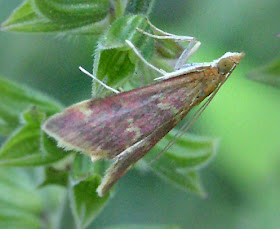 |
| Unindentified crambid moth on goldenrod, drinking nectar with its long tongue |
So, here is the exception, and it is an interesting one: a moth that depends on the senita cactus. In turn the cactus depends on the moth for pollination, a nice example of mutualism. It is the Upiga virescens (common name senita moth); a non-descript little creature that carries pollen from flower to flower of the Lophocereus cactus and its larvae feeds on the seeds of this plant. Sorry, no photos.
Among the more colorful crambids that visit flowers are the Desmia Grape Leaffolder, the Raspberry Pyrausta, and the Orange Mint Moth.
 |
| Desmia Grape Leaffolder (Desmia sp.) trapped by a carnivorous sundew |
 |
| Raspberry Pyrausta (Pyrausta signatalis) |
 |
| Orange Mint Moth (Pyrausta orphisalis) |
The Spotted Webworm Moth and the Hawaiian Beet Webworm are perhaps a little less conspicuous. The latter is not a native moth, introduced from Hawaii as the name indicates.
 |
| Spotted Webworm Moth (Hymenia perspectalis) |
 |
| Hawaiian Beet Webworm (Spoladea recurvalis) |
The Celery Leaftier is very plain as are a large number of members of this family.
 |
| Celery leaftier (Udea rubigalis) |
Moths as Pollinators
List of articles
Beginners Guide to Pollinators and Other Flower Visitors
© Beatriz Moisset. 2012
I have a similar little moth in my yard called the Mint Moth, (Pyrausta aurata). It benefits from a small patch of mint in the yard but I also see them pollinating other flowers in the garden. I'm always glad to see them flitting about in the daytime.
ReplyDeleteBronzer: thanks for your comment. I guess that you are in the UK or somewhere in Europe. The species you mention is not found in the US. It is wonderful that you have been observing it enough to become familiar with it.
ReplyDelete